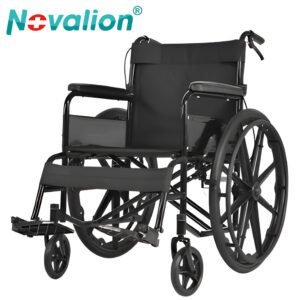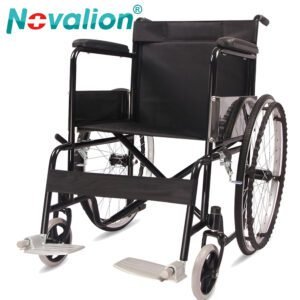Height Adjustable Wheelchair: 5 Key Questions Answered—From Adjustment Ranges to User Fit & Daily Use
A height adjustable wheelchair isn’t just a mobility aid with a flexible seat—it’s a solution to the “one-size-fits-all” problem that plagues standard wheelchairs. By letting users raise or lower their seat height, it adapts to diverse bodies, surfaces, and daily needs. But how does this adjustment work, who benefits most, and what makes a quality model? Here’s a detailed breakdown.
1. What Is a Height Adjustable Wheelchair? (Definition & Core Traits)
A height adjustable wheelchair is designed with a seat that can be raised or lowered to match the user’s height, activity, or environment. Key features include:
- Adjustment Range: Most models offer 16–22 inches of seat height from the floor, with advanced versions reaching 14–24 inches. This covers scenarios from sitting at a child’s desk (low) to reaching a kitchen counter (high).
Mechanism Types:
- Manual: Operated via a crank or lever (requires physical effort, ideal for budget-focused users or caregiver-assisted use).
- Powered: Electric motor with joystick control (effortless adjustment, perfect for users with limited strength).
- Stability Design: Reinforced frames (steel or aluminum) with extra bracing prevent wobbling, even at maximum height. Safety locks engage automatically to avoid sudden drops.
- Key Purpose: To align the user’s seat with surrounding surfaces (tables, beds, desks) without forcing them to hunch, stretch, or rely on cushions.
2. How It Differs from Standard Wheelchairs
The height adjustment feature creates critical advantages over fixed-height models:
- Surface Alignment: Standard wheelchairs (fixed at 19–20 inches) leave users straining to reach high counters or hunching at low tables. Adjustable models eliminate this by matching seat height to the surface.
- Growth Adaptability: Children’s wheelchairs often need replacement every 1–2 years as they grow. Height adjustable versions adapt over 3–5 years, reducing costs and hassle.
- Transfer Ease: Aligning the seat with beds or chairs simplifies transfers for seniors, post-surgery patients, or anyone with limited mobility.
- Versatility: One wheelchair works for home (low couches), work (desks), and outings (restaurant booths), replacing the need for multiple aids.
3. Ideal Users: Who Needs This Wheelchair?
It’s transformative for users with dynamic needs:
- Growing Children: Kids with mobility conditions (e.g., spina bifida) can use the same wheelchair from ages 5 to 12 by adjusting the height as they grow.
- Short or Tall Adults: Users under 5’0” or over 6’0” struggle with standard heights; adjustability ensures their feet rest flat and arms reach comfortably.
- Multi-Surface Users: Teachers, chefs, or caregivers moving between desks, stoves, and beds benefit from on-the-fly height changes.
- Caregiver-Supported Users: Lowering the seat reduces lifting strain for caregivers; raising it eases transfers to beds or chairs.
4. Key Features of Height Adjustment
Adjustment Mechanism:
- Manual: Crank-style levers are durable and affordable ( $800–$1,500 ) but require strength to operate. Best for users with consistent caregiver help.
- Powered: Electric motors ( $2,000–$4,000 ) let users adjust height in seconds via joystick. Ideal for independent use.
Safety Locks: Must engage with an audible “click” to prevent accidental movement. Look for models with dual locks (mechanical + electronic) for added security.
Range Flexibility: A minimum 6-inch adjustment (e.g., 16–22 inches) ensures versatility. For specialized use (e.g., pediatric to adult), opt for 14–24 inches.
Weight Capacity: Standard models support 250–350 lbs; bariatric versions (400+ lbs) are available but slightly bulkier.
5. Real-World Use: Where It Shines
Home Settings:
- Lower the seat to 16–18 inches to sit at a dining table or transfer to a couch.
- Raise it to 20–22 inches to reach kitchen counters or bathroom sinks.
Work & School:
- Match desk heights (29–30 inches) by setting the seat to 18–19 inches, promoting ergonomic typing or writing.
Public Spaces:
- Adjust to restaurant booths (low) or checkout counters (high) for independent interactions.
Travel:
- Foldable manual models (35–50 lbs) fit in car trunks, adapting to hotel beds or café tables.
6. Buying Considerations
- Adjustment Range: Choose based on your needs. For home use, 16–20 inches suffices; for work/errands, 18–22 inches is better.
- Power vs. Manual: Powered models offer independence but cost more; manual versions are budget-friendly and lighter for travel.
- Stability Testing: Ensure the wheelchair remains steady at maximum height—wiggle the seat gently to check for wobbling.
- Foldability: If you travel, prioritize manual foldable models (powered versions are heavier and harder to store).
- Warranty: Look for 2+ years of coverage, especially for adjustment mechanisms (motors, cranks) which wear with frequent use.
Conclusion
A height adjustable wheelchair is a tool for empowerment. It lets users interact with the world on their terms—no more straining, hunching, or relying on others to adjust their environment. Whether you’re a growing child, a tall adult, or someone who moves between diverse surfaces daily, this wheelchair adapts to you, not the other way around.
Thank you for reading this, dear, if you have any suggestions about our website or want to know about wheelchair, please contact us. We will respond quickly.



